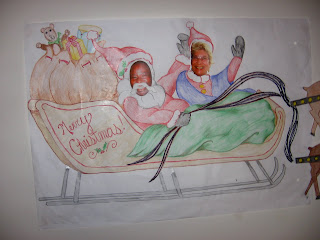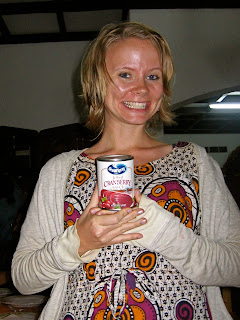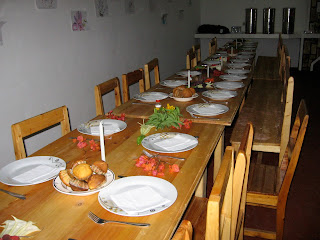Because you only swear in once... oh wait
After another 10 weeks of mentally grueling training, I am officially a Peace Corps Rwanda Volunteer. Our swear-in was held on Saturday at U.S. Ambassador Stuart Symington's residence in Kigali. He has a lovely backyard where we held our ceremony under some tents. Our country director, John Reddy, gave a few words of welcome, and then we had some short thank you speeches from PCVs: Michele and Kevin together in Kinyarwanda, I in French, and lastly Katy in English. Then the ambassador gave us some words of encouragement, and we swore our oath. The oath is the most exciting part to me because it's the same words that all U.S. government employees recite. (The PCVs from Mauritania did not technically need to take the oath again, but most of us chose to repeat it anyway.)



Following the ceremony we had some delicious catered food and entertainment from a traditional dance and drum troupe. We were told that the group was created to give opportunities to children from "disadvantaged" backgrounds. Each year they travel internationally, and last time they took first place for all of Africa in a competition in Holland. I am awestruck by how gracefully some of these children can move. One girl pulled me up to join her in a dance at the end. She kept pushing my arms up higher and then would nod with satisfaction when I got them in the right place. It was fun, even though she far outshone me!

Perhaps the only sad thing about training being over was having to say goodbye to our LCFs (Language and Cross-Culture Facilitators, which is fancy Peace Corps-speak for "teachers"). Our relationship with LCFs here was much different than in Mauritania. There they were all male and at least 45 years old. Here there were more female than male, and their average age was 26. (I'm 25.) Also, in Mauritania we had the same LCF for all of training, but here we would switch often so we got to know everyone. They were definitely more like peers here, and we would go out to meals and bars with them in the evenings.


Last week we had a farewell party with a Secret Santa gift exchange, and I was put in charge of the decorations. We had already bedecked the room with paper snowflakes and stockings I sewed out of dental floss (PCVs gotta be resourceful!), but the final pièce de résistance was a one-of-a-kind winter landscape. It included hand-sketched Santa and Mrs. Claus in a sleigh drawn by 12 reindeer, with a few elves looking on -- but each character's face was one of our training staff! Unsurprisingly I ran into a big hassle trying to print the photos, but in the end everything turned out so amazing, thanks to the help of many artistically talented PCVs. I'm not sure the Rwandans really "got" what the scene represented (considering one told me, "Oh, they're goats!"), but they really appreciated it and many were taking photos of themselves next to their little characters.


I'm sure you all know that Peace Corps Volunteers don't earn much in the way of money during our service, but we do get a nice one-time "settling-in allowance" just after swearing in. Consequently on Monday, fresh from opening our new bank accounts, we all raided the shops in Kigali and purchased more than we could ever need for our new homes. Pots, and pans, sugar and spices, brooms and buckets -- we're ready to go! Peace Corps gave us some nice heavy-duty foot lockers to pack our goodies in, and we hauled everything back to Nyanza. We'll be here for Christmas together, and then we begin dispersing to our sites on Monday (in Peace Corps transportation, thankfully). Can't wait!
'Til then, I've got Christmas tunes on my iPod, Christmas lights from Kigali, and Christmas joy in my heart. ;) Wishing you the best. Noheri Nziza!












 Read my retired
Read my retired